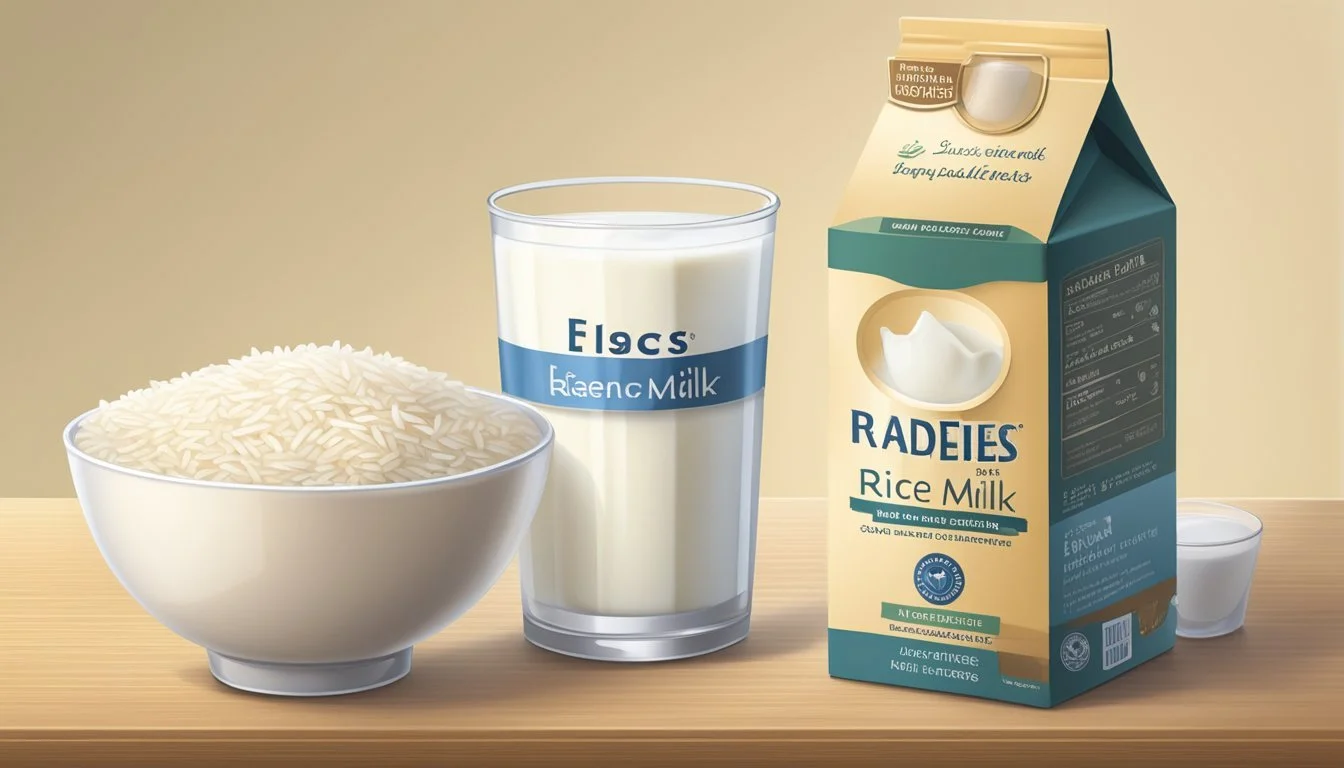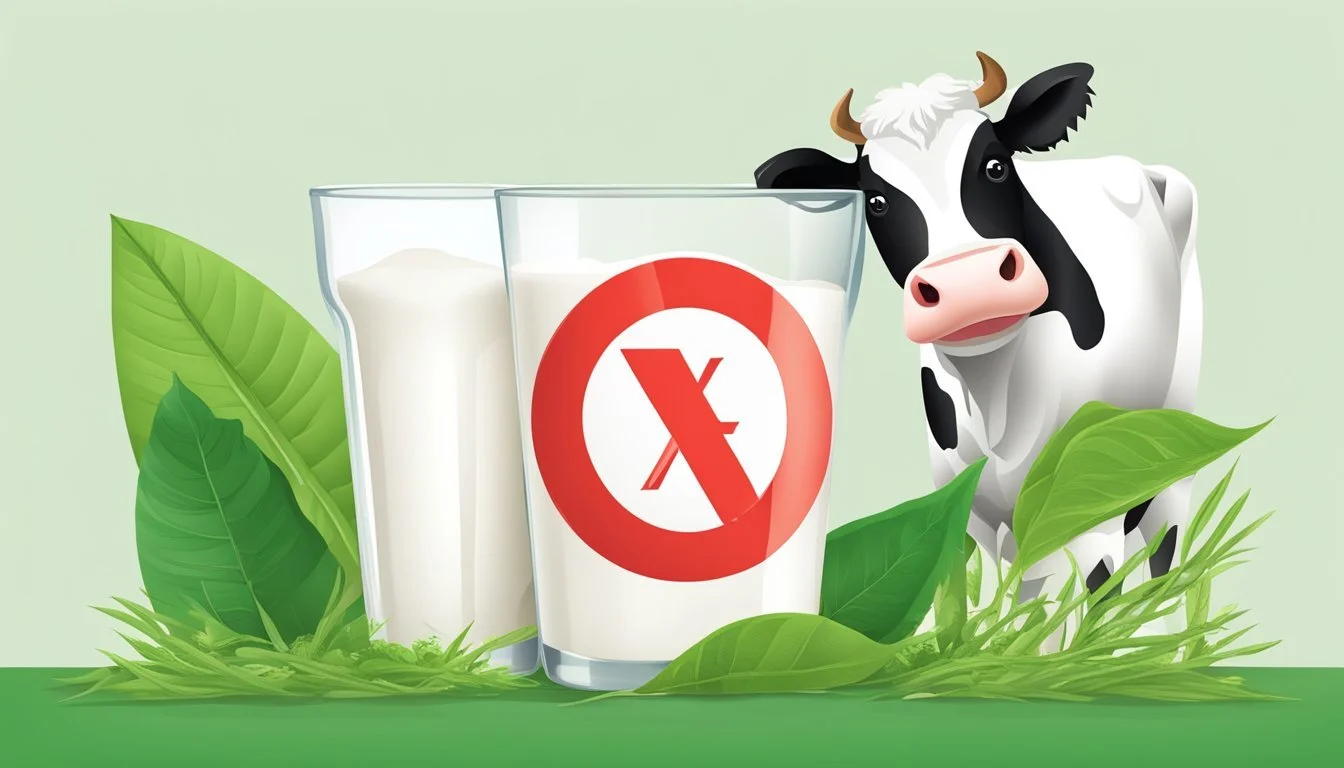Is Rice Milk a Good Alternative for Lactose Intolerance?
Exploring Dairy-Free Options
For individuals with lactose intolerance, finding suitable alternatives to dairy milk is essential. Rice milk emerges as a noteworthy option, offering a lactose-free solution for those who experience discomfort from dairy products. Unlike cow's milk that contains a sugar called lactose, which can trigger adverse reactions in lactose-intolerant people, rice milk is derived from milled rice and water, hence it does not provoke these symptoms.
Given that it's plant-based, rice milk caters to the dietary requirements of vegans and those with lactose intolerance or a milk allergy. Its naturally sweet taste makes it a pleasant addition to cereals and beverages. However, rice milk is noticeably lower in protein compared to cow's milk and lacks certain essential vitamins and minerals unless it is fortified. Therefore, when considering rice milk as a daily dairy milk substitute, it's important to account for these nutritional differences.
Despite its suitability for those avoiding lactose, rice milk's higher carbohydrate content may not make it the best option for everyone, especially for individuals managing conditions such as diabetes. Food and health organizations often advise choosing fortified varieties that are enriched with nutrients like calcium and vitamin D to help ensure a balanced diet. Rice milk's place in a healthy diet largely depends on an individual's overall nutritional needs, other food intake, and personal health goals.
Understanding Lactose Intolerance
Lactose intolerance is an inability to digest lactose, leading to various digestive symptoms. This condition revolves around the lactase enzyme's crucial role in digestion.
What Is Lactose Intolerance?
Lactose intolerance occurs when an individual's digestive system cannot break down lactose, a sugar found in milk and dairy products. This condition is not an allergy to milk but rather a deficiency in lactase, the enzyme needed to digest lactose. When someone with lactose intolerance consumes dairy, undigested lactose passes through the gastrointestinal tract and can cause symptoms such as:
Bloating: A feeling of fullness or swelling in the abdomen.
Diarrhea: Frequent, loose, watery stools.
Not everyone has the same threshold for lactose, and symptoms can vary greatly in severity.
Lactase Enzyme and Digestive Challenges
The enzyme lactase is essential for breaking down lactose into simpler sugars that can be absorbed into the bloodstream. In individuals with lactose intolerance, lactase production is insufficient, leading to:
Difficulty in digesting dairy products.
Incomplete lactose breakdown resulting in fermentation by gut bacteria, causing gas and discomfort.
For those who are lactose intolerant, finding alternatives to dairy is often necessary to avoid the discomfort associated with these digestive challenges.
The Basics of Rice Milk
Rice milk, a plant-based liquid derived from rice grains, presents an alternative for those who avoid dairy due to allergies or dietary choices. It stands out for its hypoallergenic properties and digestibility.
Rice Milk Composition
Rice milk primarily comprises carbohydrates, as rice is a starchy grain. Unlike cow's milk, it contains minimal fat and protein, making it lighter in consistency but less nutritionally dense in these components. The basic composition of rice milk includes:
Carbohydrates: A primary energy source, contributing to rice milk's higher carbohydrate content relative to other milk alternatives.
Fats: Usually low in rice milk, but certain brands may add vegetable oils to enrich the texture and caloric content.
Sugars: Naturally occurring sugars are present, while some manufacturers may add sweeteners to improve taste.
Vitamins and Minerals: Often fortified with calcium, vitamin D, and other nutrients to bolster its nutritional profile.
The final product, a rice drink, provides an easy-to-digest, lactose-free beverage suitable for vegans and those with lactose intolerance.
Commercial Production of Rice Milk
The commercial process of rice milk production generally involves several steps to transform whole rice into a liquid drink:
Milling: Rice grains are milled to break them down.
Cooking: The milled rice is then cooked until soft.
Blending: The cooked rice is blended with water to create a smooth mixture.
Enriching: This liquid is commonly fortified with vitamins and nutrients.
Flavoring: Additional flavorings or sweeteners might be added.
Packaging: The product is packaged for sale, typically in cartons or bottles, after homogenization and pasteurization to ensure safety and shelf stability.
Through this process, rice milk is made widely available for consumers seeking non-dairy alternatives.
Nutritional Profile
Rice milk provides an alternative source of nutrients for those with lactose intolerance and can be compared to other milk alternatives in terms of nutritional content.
Macro and Micronutrients in Rice Milk
Rice milk typically offers a different nutritional profile compared to dairy milk. It is naturally lactose-free and low in protein, making it a suitable option for individuals with lactose intolerance or milk allergy. However, rice milk is naturally low in protein and may require fortification to match the nutrient levels found in cow's milk.
A standard cup of fortified rice milk may contain:
Calories: About 120
Protein: 1 gram or less
Fat: 2 to 3 grams (primarily unsaturated fat)
Carbohydrates: 22 to 24 grams
Fiber: Minimal quantities
As for micronutrients, rice milk is often fortified with vitamins and minerals such as:
Calcium: Comparable to that in cow's milk when fortified
Vitamin D: Often added to mirror the levels in fortified dairy milk
Vitamin A: Included in some commercial brands
Vitamin B12: Sometimes added to enhance its nutritional value
Comparison with Other Milk Alternatives
When comparing rice milk to other plant-based alternatives, each has its distinctive nutritional advantages.
Soy Milk: Known for its higher protein content, a cup of soy milk typically contains 8 grams of protein and is rich in vitamins and minerals including vitamin D, calcium, and potassium.
Almond Milk: Usually lower in calories and fat than dairy milk, almond milk contains heart-healthy monounsaturated fats and is often fortified with calcium and vitamin E.
Oat Milk (unsweetened): Rewards with higher fiber content, contributing to its caloric value close to cow's milk.
Comparative Table:
Nutrient Rice Milk (Fortified) Cow's Milk (2%) Soy Milk Almond Milk Oat Milk (unsweetened) Protein (g) 1 or less 8 8 1 4 Calcium (mg) 309 (when fortified) 293 Varies (fortified) Varies (fortified) Varies (fortified) Vitamin D (mcg) 2.8 (when fortified) 2.9 Varies (fortified) Varies (fortified) Varies (fortified) Fat (g) 2 to 3 4.7 Varies Varies Varies Carbs (g) 22 to 24 12 Varies Varies Varies
While rice milk can be fortified to enhance its nutritional profile, it naturally contains fewer vitamins and minerals than other milk alternatives. Consumers should check the labels for fortification of vitamins like D and B12, as well as minerals such as calcium and phosphorus.
Health Benefits and Risks
When considering rice milk as a dairy alternative for those with lactose intolerance, it's important to weigh both its health benefits and potential health concerns. This beverage provides certain nutritional advantages while also posing some risks that consumers should be aware of.
Pros of Rice Milk for Health
Rice milk is a lactose-free beverage, making it suitable for individuals with lactose intolerance or milk allergies. It is also vegan-friendly, meeting the dietary restrictions of those who avoid animal products. Compared to whole milk, rice milk is generally lower in calories, which can be beneficial for individuals aiming to manage their calorie intake.
Calories: Approximately 120 calories per 8-ounce serving
Fat Content: Low in fat and contains no saturated fat
Moreover, some brands of rice milk are fortified with essential vitamins and minerals to help support bone health, such as calcium and vitamin D, and to provide other nutrients like vitamin B12.
Vitamin D: Enhances calcium absorption
Calcium: Essential for strong bones
Vitamin B12: Often added to support red blood cell production
Potential Health Concerns
While rice milk can be a healthy choice for some, there are concerns to consider. Unfortified rice milk is not a good source of protein and often lacks the vitamins and minerals present in cow's milk, which can lead to nutritional deficiencies if not included from other sources in the diet. Additionally, consumers should be aware of the potential presence of arsenic in rice milk, as rice tends to absorb arsenic more readily from the environment. Long-term exposure to high levels of arsenic can pose health risks.
Protein: Significantly lower in protein than cow's milk
Arsenic: Check for brands that test and limit arsenic levels
Sweetened varieties of rice milk can also be high in added sugars, which may not be beneficial for those monitoring sugar intake for reasons related to heart health or diabetes. As such, choosing unsweetened versions is advisable for individuals concerned about sugar consumption.
Added Sugars: Opt for unsweetened varieties to minimize sugar intake
Dietary Considerations
Rice milk provides certain nutritional benefits and can be adapted to support different dietary needs and goals, including weight management.
Rice Milk in Weight Management
Rice milk has a distinct calorie content that must be considered within the context of an individual's diet. It typically contains:
Calories: Approximately 120 calories per 8-ounce serving
Fat: Similar amounts of fat to low-fat dairy options
In terms of weight loss, it's important to note that rice milk is lower in calories than whole dairy milk but higher than skim milk. Therefore, it may be more suitable for those managing caloric intake, but it's still necessary to consider the overall dietary pattern and portion sizes.
Suitability for Various Diets
Rice milk's suitability for various diets lies in its ingredient composition:
Lactose-free: Ideal for those with lactose intolerance.
Plant-based: Aligns with a vegan lifestyle.
Gluten-free: Can be suitable for those with gluten-related disorders provided it is certified or labeled as such.
While it comes with health advantages for those with dietary restrictions, rice milk is often lower in protein compared to other milk alternatives. Hence, it may require supplementation from other protein sources within the diet.
Taste and Culinary Uses
The flavor of rice milk and its versatility in cooking and baking make it a prevalent choice for those with lactose intolerance.
Flavor Profile of Rice Milk
Rice milk offers a subtly sweet and neutral taste, making it a versatile dairy alternative. Different brands may have slight variations in sweetness, but typically, rice milk does not overpower other flavors in a recipe. Due to its minimalistic flavor profile, it is often compared to a watered-down version of cereal milk and can be a preferred choice for those who favor a more understated taste in their dairy substitutes.
Cooking and Baking with Rice Milk
In recipes, rice milk can replace cow's milk at a 1:1 ratio, maintaining moisture and binding ingredients without significantly altering the taste. Its neutral taste ensures that the flavors of other ingredients remain prominent. Rice milk's thin consistency works particularly well in:
Liquid-based dishes: such as soups and smoothies.
Baked goods: rice milk can be used in baking cakes, muffins, and especially bread, where it contributes to the tenderness of the crumb without adding a distinguishable flavor.
Consumer Choices
When selecting rice milk, consumers face a range of options from plain, unsweetened varieties to flavored and fortified products. Personal preference and nutritional needs guide the choice.
Types of Rice Milk Available
Rice milk is typically derived from brown rice and it can be found in both organic and conventional forms. The market offers diverse flavors and additional ingredients, including:
Plain Rice Milk: Made from rice and water, this is the simplest form.
Vanilla Rice Milk: Infused with vanilla flavor, appealing for its sweet taste.
Sweetened Rice Milk: Contains added sweeteners for enhanced taste.
Unsweetened Rice Milk: Lacks sweeteners, preferred by those monitoring sugar intake.
Fortified Rice Milk: Enhanced with vitamins and minerals such as calcium and vitamin B12.
Choosing the Right Rice Milk Product
When selecting a rice milk product, consumers should contemplate nutritional content, dietary restrictions, and flavor preferences. For optimal health benefits, one might consider:
Criteria Consideration Nutritional Needs Fortified options for additional nutrients. Dietary Restrictions Organic products to avoid pesticides; Unsweetened for lower sugar intake. Flavor Preference Vanilla for a sweet, aromatic profile; Plain for a neutral taste that complements other foods.
When looking at the ingredients, it is important to verify that fortified rice milk provides enough calcium and vitamin B12, which are vital for maintaining bone health and metabolic functions, respectively. Those seeking organic rice milk should ensure that the product is certified organic, which guarantees that the rice was grown without synthetic pesticides and herbicides.
Ethical and Environmental Considerations
In the realm of dairy alternatives, both ethical and environmental factors play significant roles in the discussion. These considerations are increasingly guiding consumer choices toward plant-based options like rice milk.
Impact of Rice Milk Production
Rice cultivation requires considerable amounts of water, with one kilogram of rice necessitating about 2,500 liters of water. However, the water footprint of rice milk is still substantially lower than that of cow's milk. Rice farming can also contribute to methane emissions, a potent greenhouse gas, through the anaerobic conditions of water-logged paddy fields. Strategies such as alternate wetting and drying (AWD) techniques are being adopted to reduce this impact.
Resource Use:
Water: Extensive for rice cultivation
Greenhouse Gas Emissions: Methane from paddies
Mitigation Efforts:
AWD Techniques
Improved irrigation
Ethical Aspects of Plant-Based Milks
Individuals may choose plant-based milks like rice milk for ethical reasons, including the welfare of animals and a desire to reduce their ecological footprint. As rice milk is made from plants, it circumvents the animal welfare concerns associated with dairy farming. Additionally, plant-based milks contribute to a lower environmental impact. A plant-based diet, including rice milk, typically requires fewer natural resources and results in lower greenhouse gas emissions compared to diets that include animal products.
Plant-based milks also provide a viable option for those who follow a vegan lifestyle, upholding their ethical commitment to avoid animal products. As consumer awareness of the ethical implications of food choices grows, the demand for plant-based dairy alternatives, including rice milk, continues to rise.
Factors Influencing Ethical Choices:
Animal Welfare: Avoidance of animal-based products
Environmental Responsibility: Reduced resource use and emissions
Vegan Lifestyle: Alignment with ethical commitments
Conclusion
Rice milk stands as a commendable lactose-free alternative for individuals with lactose intolerance or those following a vegan diet. It is a plant-based milk substitute that is devoid of lactose, making it a gentle choice for the digestive system. Additionally, rice milk typically contains no saturated fat, which could be beneficial for someone monitoring their fat intake.
However, when it comes to protein content, rice milk often lags behind compared to dairy milk and other plant-based alternatives like soy milk. For those who are health conscious, it is important to note that while rice milk supports heart health due to its lack of saturated fats, it does not naturally contain significant amounts of calcium or vitamin B12, nutrients that are prevalent in cow's milk. Hence, choosing fortified rice milk is advisable to ensure the intake of these necessary nutrients.
In terms of sustainability, rice milk presents an eco-friendlier option than dairy milk, requiring less water and producing fewer greenhouse gas emissions. It caters to the growing demand for sustainable food choices that have a minimal impact on the environment.
They should consider rice milk as a suitable choice if they require a dairy milk substitute that is lactose-free and aligns with a plant-based lifestyle. Despite its lower protein content, rice milk can still serve as part of a balanced diet when consumed with a variety of other protein sources.






